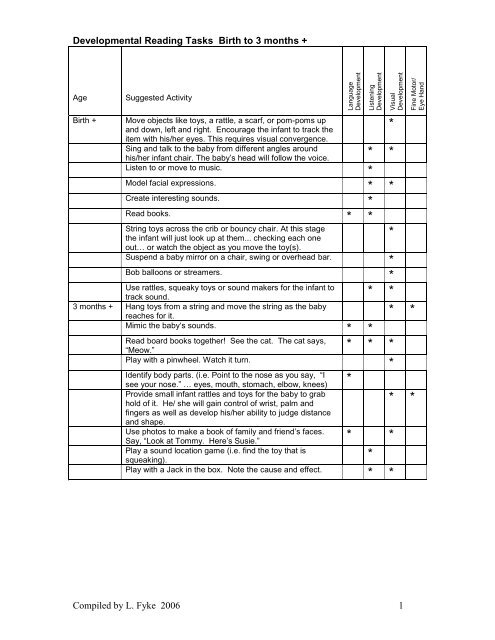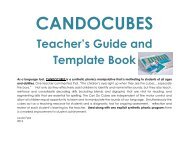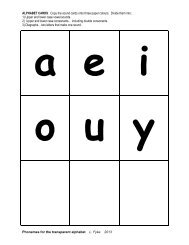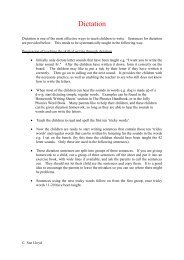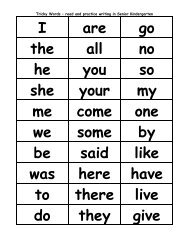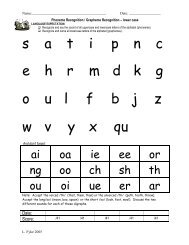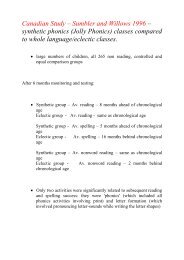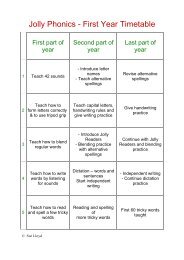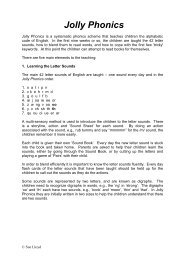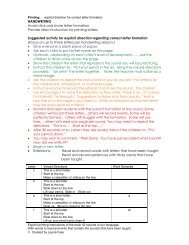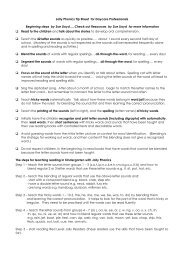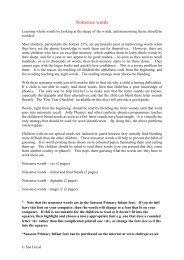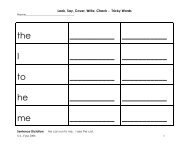Developmental Tasks.pdf - Primarily Learning
Developmental Tasks.pdf - Primarily Learning
Developmental Tasks.pdf - Primarily Learning
You also want an ePaper? Increase the reach of your titles
YUMPU automatically turns print PDFs into web optimized ePapers that Google loves.
Language<br />
Development<br />
Listening<br />
Development<br />
Visual<br />
Development<br />
Fine Motor/<br />
Eye Hand<br />
<strong>Developmental</strong> Reading <strong>Tasks</strong> Birth to 3 months +<br />
Age<br />
Suggested Activity<br />
Birth +<br />
Move objects like toys, a rattle, a scarf, or pom-poms up<br />
and down, left and right. Encourage the infant to track the<br />
item with his/her eyes. This requires visual convergence.<br />
Sing and talk to the baby from different angles around<br />
his/her infant chair. The baby‟s head will follow the voice.<br />
* *<br />
Listen to or move to music.<br />
*<br />
Model facial expressions.<br />
* *<br />
Create interesting sounds.<br />
*<br />
Read books.<br />
* *<br />
*<br />
String toys across the crib or bouncy chair. At this stage<br />
the infant will just look up at them... checking each one<br />
out… or watch the object as you move the toy(s).<br />
Suspend a baby mirror on a chair, swing or overhead bar.<br />
*<br />
Bob balloons or streamers.<br />
*<br />
Use rattles, squeaky toys or sound makers for the infant to<br />
track sound.<br />
* *<br />
3 months + Hang toys from a string and move the string as the baby<br />
reaches for it.<br />
* *<br />
Mimic the baby„s sounds.<br />
* *<br />
Read board books together! See the cat. The cat says,<br />
“Meow.”<br />
* * *<br />
Play with a pinwheel. Watch it turn.<br />
*<br />
Identify body parts. (i.e. Point to the nose as you say, “I<br />
see your nose.” … eyes, mouth, stomach, elbow, knees)<br />
*<br />
Provide small infant rattles and toys for the baby to grab<br />
hold of it. He/ she will gain control of wrist, palm and<br />
fingers as well as develop his/her ability to judge distance<br />
and shape.<br />
Use photos to make a book of family and friend‟s faces.<br />
Say, “Look at Tommy. Here‟s Susie.”<br />
* *<br />
Play a sound location game (i.e. find the toy that is<br />
squeaking).<br />
*<br />
Play with a Jack in the box. Note the cause and effect.<br />
* *<br />
*<br />
* *<br />
Compiled by L. Fyke 2006 1
Language<br />
Development<br />
Listening<br />
Development<br />
Visual<br />
Development<br />
Fine Motor/<br />
Eye Hand<br />
<strong>Developmental</strong> Reading <strong>Tasks</strong> 6 to 12 months +<br />
Age<br />
Suggested Activity<br />
6 months+ Open a gift or a wrapped article.<br />
*<br />
Present toys with cylinders, and dials that whirl and spin and<br />
make noise.<br />
* *<br />
Play with pop up toys.<br />
* *<br />
Spin tops.<br />
*<br />
Dump objects.<br />
*<br />
Play ball.<br />
* *<br />
Catch a bubble.<br />
* *<br />
Make music with an xylophone, drums, toy piano.<br />
* *<br />
Use a flashlight and spot an object. Where did the light go?<br />
* *<br />
Make shakers. This will develop a cause and effect<br />
connection.<br />
*<br />
Play with sand.<br />
*<br />
9 months+ Use early puzzles and shape boards.<br />
* *<br />
Listen to and identify sounds in the environment.<br />
* *<br />
Talk about the environment. “Look at the trees. I see a big<br />
cloud. There‟s a sunflower. The grass is green.”<br />
* * *<br />
Knock down towers.<br />
*<br />
Pour liquids or sand using funnels, cups, and pails.<br />
*<br />
* *<br />
12 months<br />
+<br />
Make an activity book with materials and paper of varying<br />
textures, ribbons, old cards, and magazine pictures. Turn<br />
pages. Point to and talk about the items in the book. “Look<br />
at the red ribbon. The black paper is really rough. Can you<br />
find the shiny gold material?”<br />
Drop balls of varying sizes into a container.<br />
*<br />
Stack rings<br />
* *<br />
Look at and turn the pages of a board book.<br />
*<br />
Sing simple songs.<br />
* *<br />
Listen to the Jolly Songs.<br />
* *<br />
Name objects as you look at them.<br />
*<br />
Introduce new words through stories, on neighborhood<br />
walks, in the environment.<br />
*<br />
Model using complete sentences.<br />
*<br />
Talk as you play developmentally appropriate games.<br />
*<br />
Notice correct use of sounds and words, do not draw<br />
attention to incorrect usage.<br />
*<br />
Give the child simple one-step directions. (i.e. Bring me your<br />
socks.)<br />
*<br />
Compiled by L. Fyke 2006 2
Language<br />
Development<br />
Listening<br />
Development<br />
Visual<br />
Development<br />
Fine Motor/<br />
Eye Hand<br />
<strong>Developmental</strong> Reading <strong>Tasks</strong> Toddler to 3 +<br />
NOTE:<br />
Remember to provide numerous and varied learning opportunities through<br />
games, music and activities for young children. Some of the activities listed may<br />
be presented when the child is a toddler. Children develop at varying rates.<br />
Some children will quickly grasp and enjoy the activity while other will need<br />
repeated and varied learning opportunities.<br />
* All of the activities listed below are presented and many are assessed during<br />
senior kindergarten.<br />
Determine which of three things is not like the other. Tell why.<br />
(Visual discrimination.)<br />
* *<br />
Determine which two of three symbols are the same. Tell why. * *<br />
I spy something big, red and round. * * *<br />
Put 3-5 things on a tray. Ask the child to try to remember the items. Look<br />
at the tray. Cover it. List items that the child remembered. Check the list<br />
with the items on the tray. Increase to 7 items. (Visual memory)<br />
* *<br />
Without identifying sounds, match 2 of three symbols that are the same.<br />
(i.e. h h n; p d p; ai ae ae)<br />
Identify environmental sounds. (Auditory discrimination) * *<br />
Make the sounds of a specific animal. * *<br />
Match two sound shakers. *<br />
Delete part of a compound word. “Say doghouse. Now say it again but<br />
don‟t say dog.” (Auditory memory)<br />
* *<br />
Clap the syllables of a word. ( i.e. dog; ti-ger; hick-or-y; hel-i-cop-ter) * *<br />
Bounce a ball or tap stick to the syllable beats of a rhyme or song. * *<br />
Delete part of a two syllable word. “Say window. Now say it again but * *<br />
don‟t say -dow.”<br />
Delete part of a three syllable word. “Say wonderful. Now say it again<br />
but don‟t say won-.”<br />
* *<br />
Make up silly rhymes. (i.e. willy, nilly: rog, bog, mog) * *<br />
Fill in the missing word in a Nursery Rhyme. (i.e. “Jack and Jill went up * *<br />
the ______”)<br />
Copy clapping patterns. *<br />
Remember a 7 digit phone number. *<br />
Determine which of three words rhyme. * *<br />
Identify if two words rhyme. * *<br />
Make a rhyme. * *<br />
Develop fine motor control by using scissors, crayons, chalk, pencils,<br />
Lego, blocks, paint, sand, plasticene, and play dough; pinching tweezers;<br />
squeezing sponges, balls or bean bags; lacing and stringing beads;<br />
tracing; etc.<br />
Encourage efforts to draw real people, objects and events. Talk about<br />
and model drawing these items using shapes and position in space.<br />
Avoid baby talk as you TALK to the child. * *<br />
READ STORIES. Have fun! Use expression. Ask questions. Dramatize! * *<br />
LOOK AT BOOKS. Talk about the picture, words, story. * *<br />
Go to the LIBRARY! *<br />
SING SONGS. Singing songs develops auditory memory skills and<br />
provides opportunities to play with words and rhymes!<br />
* *<br />
Sing the Jolly Songs to introduce the sounds of our language to children. * *<br />
Enjoy age appropriate movies. Talk about them. Sequence events. * *<br />
*<br />
Give the child a hand mirror. Encourage the child to watch his/her<br />
mouth as he/she makes a sound or says a word.<br />
*<br />
*<br />
Compiled by L. Fyke 2006 3
Language<br />
Development<br />
Listening<br />
Development<br />
Visual<br />
Development<br />
Fine Motor/<br />
Eye Hand<br />
<strong>Developmental</strong> Reading <strong>Tasks</strong> Toddler to 3 +<br />
NOTE:<br />
Remember to provide numerous and varied learning opportunities through<br />
games, music and activities for young children. Some of the activities listed may<br />
be presented when the child is a toddler. Children develop at varying rates.<br />
Some children will quickly grasp and enjoy the activity while other will need<br />
repeated and varied learning opportunities.<br />
* All of the activities listed below are presented and many are assessed during<br />
senior kindergarten.<br />
Sing the abc song. * *<br />
I spy something that starts with “x”. {sound of the letter(s)} * *<br />
I spy something that ends with “x”. {sound of the letter(s)} * *<br />
Make up a tongue twister with three or more words that start with the<br />
same sound. (i.e. She sells seashells by the seashore.)<br />
* * *<br />
Play grocery store or food bingo. * *<br />
Ask the child to cut words from a magazine that have one or more *<br />
letters from his/her name.<br />
Wear a sound, make a headband sound, or post a letter(s) on a book.<br />
Encourage the child to inquire about or identify the sound that the letters<br />
represent.<br />
Use a divided tray or T chart and sort letters. Identify your sorting rules.<br />
( i.e. These have dots. These have curves.)<br />
Use a reading window (a square hole cut in a strip of paper) and find the<br />
letter(s) that represent the sound of the day in the morning message,<br />
chart story or big book.<br />
Use a highlighter and find a specific letter or sound in a magazine or<br />
newspaper.<br />
* *<br />
* *<br />
* *<br />
* *<br />
Use magnetic letters to create words from picture and name cards. * *<br />
Use alphabet stamps. * *<br />
Print sounds in the air. This is called air writing. Provide exact * * *<br />
directions for moving the hand.<br />
Ask the child to record dictated letters sounds on a white board,<br />
chalkboard or paper.<br />
Use 8 pairs of cards and play concentration. Increase pairs as skill<br />
develops.<br />
* * *<br />
* * *<br />
Make letters or words out of playdoh or plasticene. * * *<br />
Use pipe cleaners or wikki sticks to make letters. * * *<br />
Make a graffiti board with letters or words. * * *<br />
Make rainbow letters. * * *<br />
Make large tactile letter or letter combinations. * * *<br />
Create curves and lines in finger-paint. *<br />
Support the child‟s efforts to write his/her name using lower case letters. * *<br />
Initially learn the sounds of our language (phonemes) instead of<br />
alphabet letter names. Connect the sound to the symbol(s)… (letter(s))<br />
Learn the letter names (graphemes) as you introduce tricky words. *<br />
Go on an alphabet hunt around the classroom or playground.<br />
*<br />
Using up to five cards, put them in alphabetical order.<br />
Make lily pads. Add letter sounds. The child is encouraged to hop to the *<br />
next sound heard.<br />
Make stepping stones. Ask the child to say a word that has the sound of *<br />
the next stone in it. Identify if the sound was at the beginning, middle or<br />
end of the word.<br />
Be creative! Use letters to create a new character or draw a picture. * *<br />
Make Patterns. Look for patterns in nature. * *<br />
*<br />
Compiled by L. Fyke 2006 4
Language<br />
Development<br />
Listening<br />
Development<br />
Visual<br />
Development<br />
Fine Motor/<br />
Eye Hand<br />
<strong>Developmental</strong> Reading <strong>Tasks</strong> Toddler to 3 +<br />
NOTE:<br />
Remember to provide numerous and varied learning opportunities through<br />
games, music and activities for young children. Some of the activities listed may<br />
be presented when the child is a toddler. Children develop at varying rates.<br />
Some children will quickly grasp and enjoy the activity while other will need<br />
repeated and varied learning opportunities.<br />
* All of the activities listed below are presented and many are assessed during<br />
senior kindergarten.<br />
ORALLY BLEND SOUNDS to make consonant-vowel-consonant (cvc)<br />
or cv, vc words. (i.e. Guess my word: r-e-d, -c-ar, d-o-g, g-ir-l)<br />
Orally blend sounds to make more complicated words. (i.e. Guess my<br />
word: s-t-o-p, b-e-l-t, ch-ai-n, b-l-e-n-d)<br />
Place a dot under each letter or letter combination that represents a<br />
sound. Use the dots as you point to the letter(s) to read the sounds.<br />
Blend the sounds together to read the word.<br />
Make up sound cards. Give the child a limited number of sound cards to<br />
choose from. Using those cards ask the child to find the sounds to make a<br />
word. ( i.e. s-ee, m-a-d, r-a-n, r-ai-n, d-ee-r)<br />
Play letter sound or word dominoes! (i.e. ai /ee, ee/ a: dog/cat,<br />
cat/pig, pig/cup)<br />
Make a rhyming circle using two sizes of paper plates and a brad. Try<br />
to sound out the words!<br />
Be a detective! Ask the child to look through a magnifying glass at an<br />
word and blend the sounds to read the word.<br />
* *<br />
* *<br />
* *<br />
* *<br />
ORALLY SEGMENT SOUNDS of words. ( i.e. house = h-ou-se) * *<br />
Hold up a finger for every sound heard in a word. * *<br />
Move a marker for every sound heard in a word. * *<br />
Record the sounds of words dictated by the teacher. * * *<br />
Make a shopping list. * *<br />
Introduce tricky words. Explain why they are tricky. *<br />
Make a word wall with tricky words in alphabetical order. *<br />
After learning some tricky words, and experiencing numerous successful<br />
opportunities to read decodable sentences, read simple decodable<br />
*<br />
stories.<br />
Learn how to print tricky words. *<br />
After developing fine motor control and many experiences printing<br />
sounds and recording dictated words, write short, dictated sentences.<br />
*<br />
*<br />
*<br />
* * *<br />
Write a story! * * *<br />
Encourage the child to retell a story in their own words. * *<br />
Using pictures from the story, sequence story details. * *<br />
Tell jokes and riddles! * *<br />
Ask questions and expect answers! * *<br />
Print words on index cards. Ask the child to unscramble the words to<br />
make a sentence. (i.e. I see a big tree. Look at the fat cat.)<br />
Create building word steps. Draw one step. Under the first stair write a<br />
common noun. Ask the child to think of a word to describe the noun. Add<br />
up to 5 adjectives and stairs. (i.e. Ball. Big ball. Big, red ball. Big, red,<br />
bouncy ball. Big, red, bouncy spotted ball.<br />
Talk about parts of speech when you read stories. *<br />
Talk about punctuation when you read stories. *<br />
*<br />
* *<br />
Compiled by L. Fyke 2006 5


